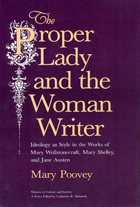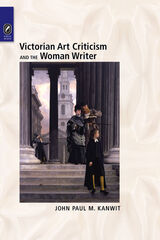3 books about Woman Writer

Lost Property
The Woman Writer and English Literary History, 1380-1589
Jennifer Summit
University of Chicago Press, 2000
The English literary canon is haunted by the figure of the lost woman writer. In our own age, she has been a powerful stimulus for the rediscovery of works written by women. But as Jennifer Summit argues, "the lost woman writer" also served as an evocative symbol during the very formation of an English literary tradition from the fourteenth through the sixteenth centuries.
Lost Property traces the representation of women writers from Margery Kempe and Christine de Pizan to Elizabeth I and Mary Queen of Scots, exploring how the woman writer became a focal point for emerging theories of literature and authorship in English precisely because of her perceived alienation from tradition. Through original archival research and readings of key literary texts, Summit writes a new history of the woman writer that reflects the impact of such developments as the introduction of printing, the Reformation, and the rise of the English court as a literary center.
A major rethinking of the place of women writers in the histories of books, authorship, and canon-formation, Lost Property demonstrates that, rather than being an unimaginable anomaly, the idea of the woman writer played a key role in the invention of English literature.
Lost Property traces the representation of women writers from Margery Kempe and Christine de Pizan to Elizabeth I and Mary Queen of Scots, exploring how the woman writer became a focal point for emerging theories of literature and authorship in English precisely because of her perceived alienation from tradition. Through original archival research and readings of key literary texts, Summit writes a new history of the woman writer that reflects the impact of such developments as the introduction of printing, the Reformation, and the rise of the English court as a literary center.
A major rethinking of the place of women writers in the histories of books, authorship, and canon-formation, Lost Property demonstrates that, rather than being an unimaginable anomaly, the idea of the woman writer played a key role in the invention of English literature.
[more]

The Proper Lady and the Woman Writer
Ideology as Style in the Works of Mary Wollstonecraft, Mary Shelley, and Jane Austen
Mary Poovey
University of Chicago Press, 1984
"A brilliant, original, and powerful book. . . . This is the most skillful integration of feminism and Marxist literary criticism that I know of." So writes critic Stephen Greenblatt about The Proper Lady and the Woman Writer, Mary Poovey's study of the struggle of three prominent writers to accommodate the artist's genius to the late eighteenth- and early nineteenth-century ideal of the modest, self-effacing "proper lady." Interpreting novels, letters, journals, and political tracts in the context of cultural strictures, Poovey makes an important contribution to English social and literary history and to feminist theory.
"The proper lady was a handy concept for a developing bourgeois patriarchy, since it deprived women of worldly power, relegating them to a sanctified domestic sphere that, in complex ways, nourished and sustained the harsh 'real' world of men. With care and subtle intelligence, Poovey examines this 'guardian and nemesis of the female self' through the ways it is implicated in the style and strategies of three very different writers."—Rachel M. Brownstein, The Nation
"The Proper Lady and the Woman Writer is a model of . . . creative discovery, providing a well-researched, illuminating history of women writers at the turn of the nineteenth century. [Poovey] creates sociologically and psychologically persuasive accounts of the writers: Wollstonecraft, who could never fully transcend the ideology of propriety she attacked; Shelley, who gradually assumed a mask of feminine propriety in her social and literary styles; and Austen, who was neither as critical of propriety as Wollstonecraft nor as accepting as Shelley ultimately became."—Deborah Kaplan, Novel
"The proper lady was a handy concept for a developing bourgeois patriarchy, since it deprived women of worldly power, relegating them to a sanctified domestic sphere that, in complex ways, nourished and sustained the harsh 'real' world of men. With care and subtle intelligence, Poovey examines this 'guardian and nemesis of the female self' through the ways it is implicated in the style and strategies of three very different writers."—Rachel M. Brownstein, The Nation
"The Proper Lady and the Woman Writer is a model of . . . creative discovery, providing a well-researched, illuminating history of women writers at the turn of the nineteenth century. [Poovey] creates sociologically and psychologically persuasive accounts of the writers: Wollstonecraft, who could never fully transcend the ideology of propriety she attacked; Shelley, who gradually assumed a mask of feminine propriety in her social and literary styles; and Austen, who was neither as critical of propriety as Wollstonecraft nor as accepting as Shelley ultimately became."—Deborah Kaplan, Novel
[more]

Victorian Art Criticism and the Woman Writer
John Paul M. Kanwit
The Ohio State University Press, 2013
Victorian Art Criticism and the Woman Writer by John Paul M. Kanwit examines the development of specialized art commentary in a period when art education became a national concern in Britain. The explosion of Victorian visual culture—evident in the rapid expansion of galleries and museums, the technological innovations of which photography is only the most famous, the public debates over household design, and the high profile granted to such developments as the Aesthetic Movement—provided art critics unprecedented social power. Scholarship to date, however, has often been restricted to a narrow collection of male writers on art: John Ruskin, Walter Pater, William Morris, and Oscar Wilde.
By including then-influential but now lesser-known critics such as Anna Jameson, Elizabeth Eastlake, and Emilia Dilke, and by focusing on critical debates rather than celebrated figures, Victorian Art Criticism and the Woman Writer refines our conception of when and how art criticism became a professional discipline in Britain. Jameson and Eastlake began to professionalize art criticism well before the 1860s, that is, before the date commonly ascribed to the professionalization of the discipline. Moreover, in concentrating on historical facts rather than legends about art, these women critics represent an alternative approach that developed the modern conception of art history. In a parallel development, the novelists under consideration—George Eliot, Charlotte Brontë, Anne Brontë, and Elizabeth Gaskell—read a wide range of Victorian art critics and used their lessons in key moments of spectatorship.
This more inclusive view of Victorian art criticism provides key insights into Victorian literary and aesthetic culture. The women critics discussed in this book helped to fashion art criticism as itself a literary genre, something almost wholly ascribed to famous male critics.
[more]
READERS
Browse our collection.
PUBLISHERS
See BiblioVault's publisher services.
STUDENT SERVICES
Files for college accessibility offices.
UChicago Accessibility Resources
home | accessibility | search | about | contact us
BiblioVault ® 2001 - 2024
The University of Chicago Press









